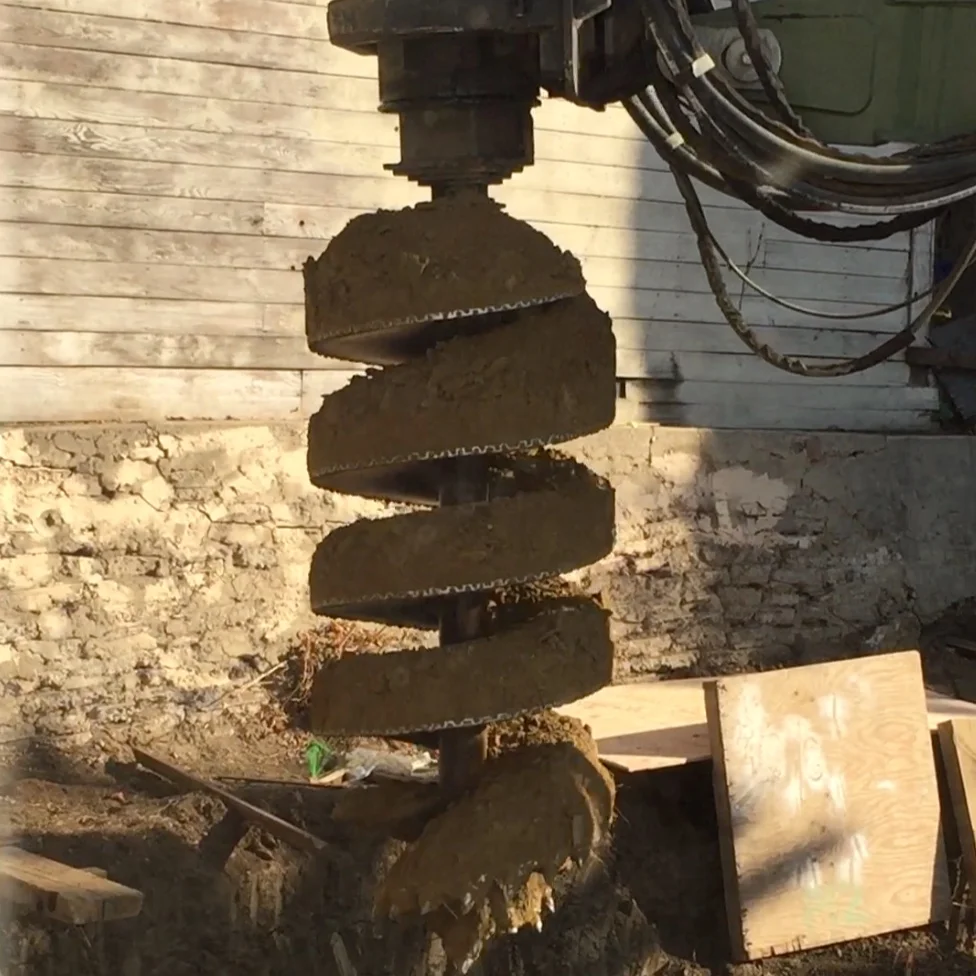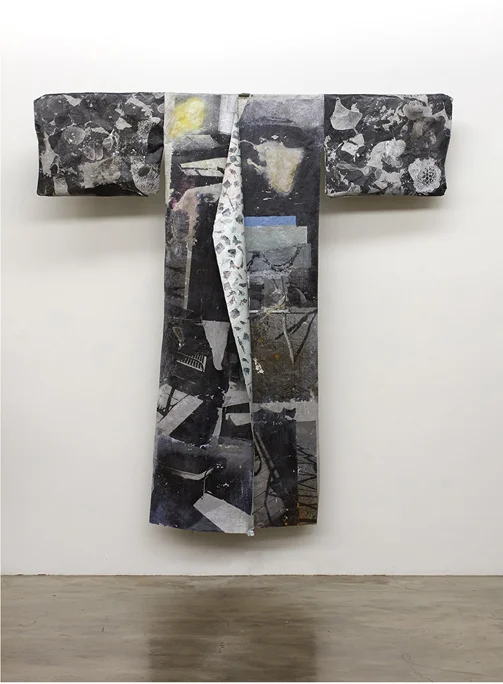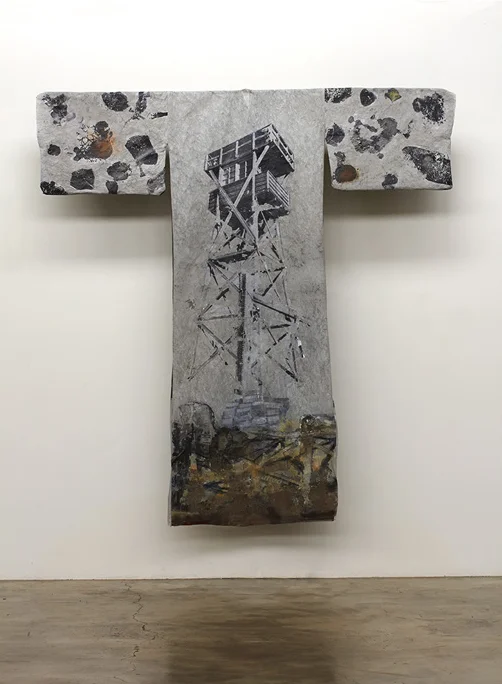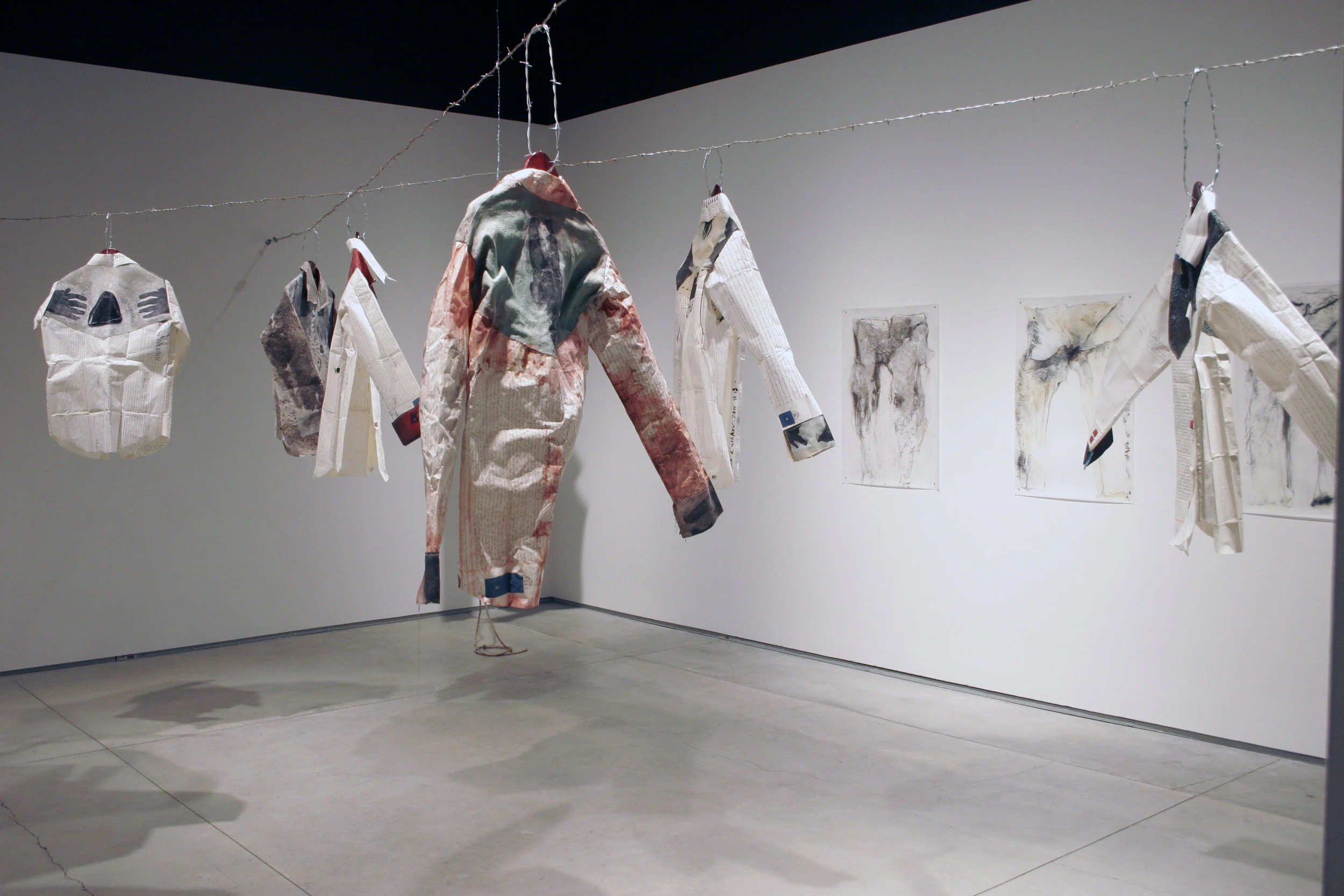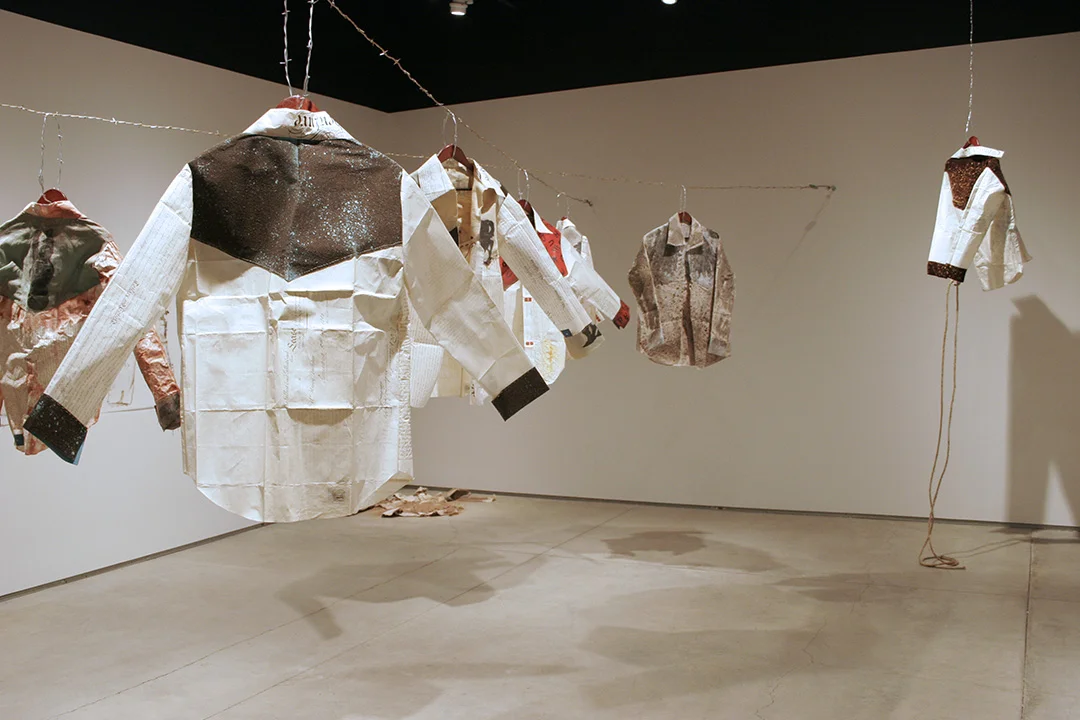THREADS
BIG RENOVATION
For the past few years I have witnessed the frantic pace of construction in the Hollywood Silverlake area where I have lived for over four decades. BIG RENOVATION is a reflection of this feverish activity prevalent in central L.A.. The ground for this piece is fiberglass mesh that is resilient enough to absorb a variety of paints, print transfers, construction materials and paper debris. Thematic and visual connections can be seen in the L.A. Random series.
Big Renovation (2015)
Acrylic, oil, crushed glass, earth , paper debris , ashes, drywall tape, powdered pigment, print transfer on fiberglass mesh
60” x 72”
ATWATER SIDEWALKS
Atwater Sidewalks (2018)
Multimedia on fiberglass mesh & Video
90” x 48”
Atwater Sidewalks Detail (2018)
Multimedia on fiberglass mesh & Video
90” x 48”
LABOR
Labor further explores the boom of construction currently underway in Los Angeles. The central figure stands for the common laborer surrounded by strips of general activity on worksites.
This scroll-like work is suspended by a wooden dowel. The imagery surrounding the central figure is based on street photographs captured and stored on my iPhone, transferred with gel medium onto fiberglass mesh, then subsequently colorized with acrylic and oil with added texture of earth, ashes, paper debris, and powdered pigments.
Labor (2018)
Acrylic, oil , powdered pigment, earth, paper debris, print transfer on fiberglass mesh
8' x 4'
Video accompaniment to the monumental Labor scroll.
MANZANAR KIMONO
After visiting Manzanar National Park, formerly Manzanar War Relocation Camp, where many thousands of Japanese Americans were incarcerated during WWII, I felt compelled to make this monumental-scale kimono, dedicated to those who suffered relocation, loss and betrayal by the U.S. government.
The front, back and sleeves of this memorial garment are imprinted with enlargements that I photographed while visiting the internment camp.
The back of the kimono displays an image of the guard tower that still stands ominously on the grounds. The front reveals pictures of rusting sleeping cots from the barracks interspersed with views of the Memorial monument. Photographs of fragments of sculptural work by artist Ruth Asawa who was interned at Manzanar, appear on the sleeves.
The fabric of the kimono is a thin polypropylene material commonly known as weed blocker. The images were transferred to the garment through the use of photocopies coated with acrylic gel medium, then pressed against the fabric. Subsequently, the surface is highlighted with acrylic paint and charcoal then rubbed with earth and ashes to provide additional texture and depth.
The enormous scale of the kimono (11’ x 6’) symbolizes the phenomenal endurance, creativity and tenacity of more than 110,000 Japanese Americans who were interned during WWII.
LOST IN
HOLLYWOOD
The central figure, Vasilisa, is an image of a young girl borrowed from a Russian folktale, illustrated by the well-known artist Ivan Bilibin. During our immigrant years in Argentina my Russian-born mother painted exact replicas of Bilibin’s image of Vasilisa carrying a glowing skull as a torch given to her by a witch who lives in a hut supported by chicken legs.
As a tribute to Olga, my mother, I have replicated an enlarged version of Vasilisa on coarse yellow mesh used in the plastering process. This mesh resembles the thread technique of cross-stitching frequently used in folk costume. I have then colorized the image in translucent washes of acrylic, touches of opaque oil and dusted with thin layers of crush glass. Vestiges of street photography from the urban environment of Los Angeles surround Vasilisa, hence the name of the piece, Lost in Hollywood.
Lost in Hollywood (2016)
Acrylic, oil , crushed glass, print transfer on fiberglass mesh
84'' x 48''
PAPER COWBOY
The climate, terrain and history of Western United States profoundly affected me during my recent residency with Ucross Foundation in April 2011. Generally my work depicts the human body, but for this project I explore the trappings of a figure that has attained mythological stature in America - the cowboy. Here, drawings and fabrications of Western shirts and well-worn chaps represent the hardworking, lonesome nomad.
PORTRAITS
Gustavo (2015)
Acrylic, pastel on fiberglass mesh
30” x 28”
Butchqueen (2017)
Oil, acrylic, print transfer on mesh
40”x 35”
INFRAMUNDO
Inframundo (Or Underworld) was inspired by the prone Christ figure placed in a tomb-like glass enclosure that resides in the Tlacolula cathedral near Oaxaca, Mexico. I depicted the Christ in a realist style reminiscent of Francisco de Zurbarán and other Spanish colonial paintings. The figure writhes from an enclosure of vestments adorned with religious motifs. At the left of the painting the face of a Zapotec man with feline eyes alludes to the indigenous population of the region. Vestiges of Zapotec writing and chicken legs hang from above the painting.
Cantinflas
Y La Suerte
Cantinflas y La Suerte was conceived in Mexico City approximately thirty years ago after witnessing a public tribute held at the Palacio de Bellas Artes after the passing of Mario Moreno, commonly known as Cantinflas. Cantinflas was an enormously popular actor featured in countless Mexican films over the course of half a decade. Referred to as the Charlie Chaplin of Mexico, he was a comic figure personifying the everyday tribulations of the common man.
The Cantinflas tapestry consists of twenty sheets of muslin imprinted with proceeds from the Lottería Nacional winning numbers and the iconic face of Cantinflas silkscreened in red. From each right eye emerges a chain tassel that trails to the floor strewn with glass crystals.
The Cantinflas tapestry was first shown in Mexico City in 1994 at the Centro Cultural San Angel. Subsequently, it was shown at CEARTE in Ensenada in 2017 as a memorial to the 25th anniversary of his death.
Cantiflas y La Suerte has recently been acquired by MACO the Museum of Contemporary Art in Oaxaca, Mexico.
Cantinflas y La Suerte (1994)
Screen print on cloth, chains and rock salt
3.6m x 3m
Cantinflas y La Suerte (1994)
Screen print on cloth, chains and rock salt
3.6m x 3m








